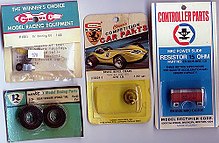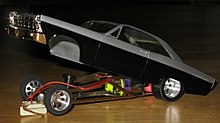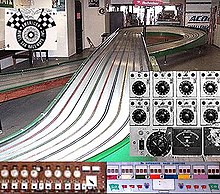Car racing track
As a car racetrack , even slotcar Bahn, Slot-Bahn (of English slot for " slot ") or in Germany after the famous there Manufacturer Carrera track a technical device is called, with the electrically powered model cars be driven on track out.
The toy industry supplies roadway parts that can be plugged together with two tracks , each with a slot for guidance and two conductor tracks for powering the model vehicles. The drivers each have a hand controller and can use it to control the speed and braking behavior of the model cars. The aim of the game is to drive laps as fast as possible without the vehicles drifting off the track, and of course to run races ( slot racing ). Carrera car racing track is often used in Germany as a synonym for slot racing .
history
precursor
Forerunner of today's slot car racing sets out the were in the first half of the 20th century by clockwork powered car models that have been held by a marginal increase in the lane.
The beginning in the 1950s
In the early 1950s , "rail racing" came into vogue in gambling-loving Great Britain , preferably in the back rooms of restaurants . The self-made vehicle models, mainly made of balsa wood and sheet brass , were guided by means of metal straps , similar to the shape of curtain rails, which were mounted on top of the driving surface. The drive was initially supposedly with miniature diesels (model aircraft engines ), later with hot rod electric motors , which mostly came from the range of the already booming model railway industry . By means of the guide rail and another flat contact strip, the model cars were supplied with electricity via sliding contacts . Since no handheld controllers were available in today's sense, steering-wheel-like rotary controls and / or Morse code-like push buttons etc. were used for speed control .
The vehicles were modeled on the original racing cars of the time, but there was no binding, defined scale. The landscape of the railway systems was also not completely designed, as is the case for B. is common in model railroad clubs. So it was primarily about holding competitions.
The boom in the 1960s
In the 1960s , the slot racing boom developed with championships and attractive prize money, initially in the USA on rental tracks , the “model car raceways” across the country. Vehicles were driven on a scale of 1:24 and a rail voltage of 12 V, which was supplied by a car battery , since stabilized power supplies were not available at the time or were extremely expensive. The tracks were rented out separately, and accessory sales were booming. Racing center with a lot of space offered several, mostly eight-lane tracks with banked turns and driving distances between 20 and 80 meters per round. Tuning , kit - and ready-to-race slot cars were offered by many companies. The first car racing track packs came to the toy trade from English companies in the mid-1950s . Manufacturers who also had model railway accessories on offer were able to prevail, e.g. B. Strombecker and Tri-Ang Scalextric .
In Germany, at the beginning of the 1960s, Scalextric launched basic packs with the “Plexi-Track System” (identical to Scalextric Classic) on a scale of 1:32. The Scalextric vehicles, which are largely true to the model, but filigree , and some with steering, are now sought-after collector's items . Almost at the same time, Stabo , known as a manufacturer of radio equipment, launched the “ Stabo Car ” rail system with somewhat rounded slot cars designed for children's hands. The Carrera company pursued a similar concept with the Universal system , which was also very successful and is still one of the best-known systems today. Other model railway manufacturers joined the trend : Märklin with “Märklin Sprint”, Fleischmann with “Auto Rallye” and Arnold with “MiniMobil”. In the case of the Minimobil, a spiral ran around in the slot, which moved the cars through carriers. The spiral was driven by an electric motor that was hidden in a gas station building. Stabo, Fleischmann and Carrera also tried to get involved in the rental railway scene with 1:24 scale kits and ready-to-race slot cars (RtR). The success, however, remained modest.
From the mid-1960s, the Cologne-based wooden railway manufacturer Minerva tried to assert itself against the US imported railway in Germany. Airfix ( MRRC ) and Revell - mainly companies known for their plastic model kits (Revell's slot car motto: "Build - Race - Win") - also brought out their own home track systems. The Revellbahn was somewhat wider and more compatible with the rental railways than the usual 1:32 products and therefore also usable for 1:24 slot cars. Stabo and Carrera have now also expanded their range. Carrera's 1:24 1:24 track system, which can be expanded to eight lanes, has now been reissued as “Carrera Exclusiv” and “Carrera Evolution” in 1:32 were and are still successful today. Stabo did not prevail with his 1:24 system.
Faller first came onto the market in a smaller scale H0 (approx. 1:64) with Faller AMS , which was actually intended as a car game to supplement H0 railways. In addition to "Faller AMS" and "Model Motoring Thunderjet 500" from the US manufacturer Aurora , with its extensive range of 1:64 slot cars equipped with the popular "T-Jet" flat armature motor , later copied by various manufacturers , tried it out also the company Reinhard & Co. with the "RASANT" -Modellautostraße (1964 to 1968) on the small scale. The Tyco company later revived this size.
Later, Faller released a somewhat confused 1:24 track system consisting of two-lane, gray plastic track parts with glued-in copper wire conductors called "Faller Club Racing". Faller equipped the associated vehicles with the then common Mabuchi 18D engines from the rental railway sector. They were available in the 1:32 and 1:24 scale as a kit and "RtR" (Ready to Race) for a short time exclusively in toy stores. Today they are sought-after rarities. Car racing tracks produced there were also sold in the GDR under the name Prefo .
End of the boom in the 1970s

The first slot car boom ended in the early 1970s . The commercial racing centers with their huge commercial areas had to close after unsuccessful attempts to revive the business by reducing the number of trains and replacing them with pinball machines , billiard tables or table tennis tables . Many accessory manufacturers completely stopped production. Both Stabo and Carrera tried to introduce a model and play landscape with construction vehicles and transport tasks based on the rail systems they had in-house, but this was not crowned with lasting success.
The new boom since the 1990s

A revival of the market only succeeded in the 1990s through manufacturers who, similar to model railways, brought very detailed vehicles onto the market that were intended for both showcases and driving. In particular, the Spanish company Fly / GB Track had triggered a surge in detail. The fact that the model cars now run on all competing rail systems, i.e. are largely compatible with one another, certainly contributed to the revival of the car racing track.
Systems
Currently there are racing tracks for cars in the scales 1:24, 1:28, 1:32, 1:43 and 1:64. The most common standard for vehicles for adults nowadays is the 1:32 scale. The "Carrera Go !!!" - tracks and their digital relatives D143 for cars on a scale of 1:43 are intended as an introduction for children from 6 years of age. The Carrera Profi , which was manufactured on the same scale, was discontinued. The systems "Carrera Universal" (three lanes) - in which two cars could drive one behind the other but independently in one lane - and "Carrera Servo" (four lanes) were possible when changing lanes are also no longer in production.
Plastic racing tracks for cars on a scale of 1:32 are currently still being produced by Scalextric , Ninco and SCX . Racing tracks for 1:24 scale cars are only offered by Carrera , which is the same track that Carrera markets for their 1:32 scale cars.
The target group for the cars in the "large" 1:32 and 1:24 scales and the plastic or wooden tracks that are suitable for this are primarily adults today - as is the case with the detailed model trains. As children's toys, simpler, mostly smaller, car racing tracks such as the Carrera GO !!! or tracks z. B. offered by Artin and Racy. Most manufacturers now offer "digital" systems. This enables several vehicles to be driven in one lane and to change lanes (via switches ).
Wooden racetracks are an alternative to plastic car racing tracks. Until recently, these tracks were reserved for professional racing centers, but manufacturers of permanently installed club racetracks now offer comparable qualities with digital racing controls and features such as automatic overtaking with collision protection for hobbyists. Private area. The company Slotfire , for example, produces wooden racing tracks for end users in scales 1:24 and 1:32. The most used track system in clubsport is from the company Plazidus , which manufactures wooden tracks in modular construction, as a kit or prefabricated elements. Due to the mostly limited space in the end consumer area, there are rail systems as well as modular systems in which the race track is integrated in freely combinable MDF panels. The manufacturers cite the most important advantages over synthetic racing tracks, among other things, in faster assembly and dismantling and the high torsional rigidity of the systems. The paintwork of the tracks also offers better grip.
vehicles
Ready-made car models are currently offered by a large number of manufacturers (1:32 scale: Carrera, Fly, Revell, Scalextric, Ninco, etc. / 1:24 scale: Carrera, ScaleAuto, BRM, JK, ProSlot, Parma). These models are mostly very detailed and true to the original and some are equipped with magnets to improve the driving characteristics. However, the use of magnets is controversial. As a rule, these are not used in slot racing clubs.
In addition to the original finished models, there are a number of manufacturers who offer chassis (e.g. Schöler, Plafit, Modern-Motor [Momo] etc.), bodies, engines, tires and other accessories for building individual models.
There are motors in the 13D, 16D and 18D designs for these models. The available motors differ in terms of dimensions, power consumption, torque and speed. While the 13D engines are used in 1:24 and 1:32 vehicles, 16D engines mostly run in so-called flexi cars and dragsters. The large 18D engines are installed almost exclusively in 1:24 vehicles.
Tires for the slot cars are available in four basic materials: silicone, solid rubber, polyurethane (PU) and foam rubber. The tires differ greatly in terms of adhesion, wear and care. E.g. PU and foam rubber tires must be sanded before use, while solid rubber and silicone tires can be used immediately.
There are a variety of bodies for the individual models. They are made from deep-drawn film, Lexan, Delrin, as finished models or in the form of kits from various model manufacturers.
There is a whole series of racing series for these individual models (e.g. DSC Cup, Parma International, Nascar 124, ...), which precisely describe the permitted vehicles in elaborate regulations.
Vehicle control
The vehicles were controlled with mechanically and electrically stable versions of the well-known thumb controller (plunger-type controller). The first choice was heavy-duty ceramic resistors with values of 5, 8, 15, 25 and 35 ohms as well as a brake contact. The brake contact makes it possible to use the generator effect of the motors when the vehicles roll out by short circuit to brake and thus to reduce the lap times. The brake is only active when the controller is in the zero position. At home railways from the toy trade, controllers with short-circuit brakes were initially unknown. In the club track area and at championships, electronic controls are used that offer a variety of setting options. The response of the engine and the braking properties of the vehicle can be individually adapted to the driver and the train. Some regulators also offer a choke, which limits the maximum voltage and thus the top speed of the vehicle.
There are different connection schemes for club tracks. In Germany the German system is used most, which is marked with red-black-yellow. Red = power source (transformer), yellow = traction current (gas), black = brake. In the international system, the Parma system is used, which is marked with white-black-red. White = power source, black = traction current (gas), red = brake. Furthermore, a distinction is made between positive path control and negative path control . The difference lies in which electrical pole is controlled by the controller. In the case of positive control, the positive pole is first fed to the path control (controller) and regulated. In the case of negative control, the positive pole is first applied to the web and the negative pole is then fed to the web control (controller) and regulated.
Timing
In the 1960s, the railway systems were equipped with impressively complex control panels. Mechanical time switches installed there (similar to a kitchen alarm clock) switched the respective train lane on and off by relay, according to the travel time to be paid in advance. The number of laps was recorded by means of electromechanical counters and “deadstrips” (contact strands separated from the traction current for each track - length approx. 25 cm). Even a microphone and loudspeaker for announcements by the “race management” were integrated into the control panels.
Inexpensive PC technology today enables a light barrier to 1/1000 sec. precise time measurement, automated rental of the track lanes coupled with cash register systems, as well as programmable racing processes in various variants.
Permanently installed club facilities
Club systems for "slot racing" or "scaler racing" are often made of MDF boards . The annoying "railroad rattle" caused by the impact of the individual plastic rail components does not occur in rail systems made of MDF boards.
The club tracks for scaleracing are mostly equipped with track braid made of steel mesh that is a little less electrically conductive . This is the only way that the standard magnetic “ traction aid” of the magnet cars, which the toy industry has now mass-produced in the Far East , is also effective on a club track.
In addition, the unpopular, sticky dirt is avoided by applying tire adhesive (glue) to the track and rear wheels. Even if the traction aid were omitted, standard magnetic vehicles would attract attention due to weak engines and manufacturing tolerances in the chassis and wheels due to unspectacular driving behavior.
High- quality chassis constructions (e.g. from Plafit , Schöler or Motor-Modern ) without traction magnets are available for the visually demanding, mostly self-made competition vehicles of the Scaleracing . A realistic appearance of the models is mandatory, as additional points are awarded for this in competitions.
Constructions made of MDF have also prevailed in the competition tracks for the “Flexi”, “WingCar” and “Vintage” classes. Since the regulations allow ground clearance down to 0.5 mm, the fibreboards are usually stabilized against warpage by plywood substructures. This guarantees the smoothest possible driving surfaces for the extremely high speeds of these slot cars (“Group7”, “Int15”, “Eurosport 12/24” etc.).
Because of the high starting currents of the motors, up to 30 amps per vehicle / lane are required for a short time at 12 volts . Therefore, car batteries or 13.8 V fixed voltage power supplies and thick copper braid for the conductors are the usual first choice. Since the influence of the strong magnets of the sophisticated motors on the road holding is undesirable, non-magnetic copper strands also ensure neutral driving behavior.
Web links
- Link catalog on the subject of racing track at curlie.org (formerly DMOZ )











